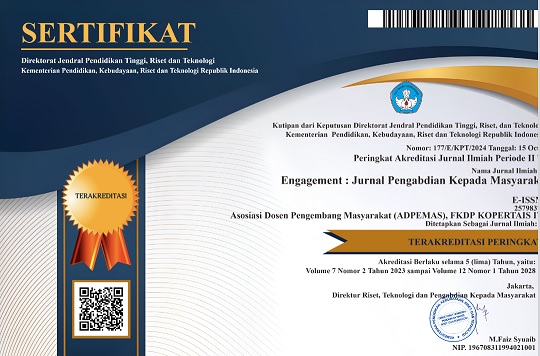Less-Crowded Tourism as Applied to Reviving Tourism Post-Covid-19 in Taram Village, Lima Puluh Kota Regency, West Sumatra through Asset-Based Community Development
Abstract
The Covid-19 pandemic has had a significant impact on the tourism industry. The decrease in the number of visitors has affected the revenue of tourism operators and the economy of the village community, especially in the tourism sector of Taram Village. The Asset Based Community Development (ABCD) approach is used to rebuild the tourism sector in the new normal era by optimizing the potential of Taram Village's outstanding tourism resources. Community support results in diversifying tourist destinations by adding variations and increasing the number of attractions, such as corn-based educational tours targeting the school-aged market segment. These support efforts have also been able to enhance the local economy through the optimization of the added value of sweet corn, transformed into pilus and gelamai products, which are culinary specialties of Taram Tourism Village. Implementing the ABCK application serves as a medium for developing Taram Tourism Village, thus achieving sustainable and resilient tourism development in Taram.
Downloads
References
Anele, Kalu Kingsley. “Assessing The Impact of COVID-19 on The Indonesian Tourism Industry” 4, no. 2 (2021): 107–120.
AUNWTO and ADB. COVID-19 and the Future of Tourism in Asia and the Pacific. UNWTO, 2022.
Badan Pusat Statistik. Statistik Objek Daya Tarik Wisata 2017, 2017. https://www.bps.go.id/publication/2019/06/25/5778b382b7bf196c4999df38/statistik-objek-daya-tarik-wisata-2017.html.
Christ, Costas, Oliver Hillel, Seleni Matus, and Jamie Sweeting. Mapping Tourism ’ s Global Footprint, 2003.
Dureau, Christopher. Australian Community Development and Civil Society Strengthening Scheme (ACCESS) Tahap II. Australian Community Development and Civil Society Strengthening Scheme (ACCESS) Tahap II, 2013.
Isnawati, Dewi Indri. “Identifikasi Masalah Dan Strategi Pengembangan Daya Tarik Wisata Alam Di Provinsi Jawa Tengah.” Fakultas Ekonomi, Universitas Negeri Semarang. Universitas Negeri Semarang, 2019.
K.Masbiran, vivi ukhwatul. “IMPACT OF THE COVID-19 PANDEMIC.” Jurnal Pembangunan Nagari 5 (2020): 148–164. https://doi.org/10.30559/jpn.v5i2.212.
Kementerian Pariwisata dan Ekonomi Kreatif, Deputi Bidang Strategis. Tren Industri Pariwisata 2021. Jakarta: invent.ure, 2020.
Muhammad, Fauzan Noor, and S E Par. Indikator Pengembangan Desa Wisata. Malang-Indonesia: CV Literasi Nusantara Abadi, 2021.
Nanno, Mulder (coord.). “The Impact of the COVID-19 Pandemic on the Tourism Sector in Latin America and the Caribbean , and Options for a Sustainable and Resilient Recovery Thank You for Your Interest in This ECLAC Publication.” International Trade series (2020). https://repositorio.cepal.org/handle/11362/46502.
Nel, Hanna. “A Comparison between the Asset-Oriented and Needs-Based Community Development Approaches in Terms of Systems Changes.” Practice 30, no. 1 (2018): 33–52. http://doi.org/10.1080/09503153.2017.1360474.
Olson, D. M., E. Dinerstein, E. D. Wikramanayake, N. D. Burgess, G. V.N. Powell, E. C. Underwood, J. A. D’Amico, et al. “Terrestrial Ecoregions of the World: A New Map of Life on Earth.” BioScience 51, no. 11 (2001): 933–938.
Orîndaru, Andreea, Maria Floriana Popescu, Alina Petronela Alexoaei, Ștefan Claudiu Căescu, Margareta Stela Florescu, and Anca Olguța Orzan. “Tourism in a Post-Covid-19 Era: Sustainable Strategies for Industry’s Recovery.” Sustainability (Switzerland) 13, no. 12 (2021): 1–22.
Park, In Jo, Jungkeun Kim, Seongseop (Sam) Kim, Jacob C. Lee, and Marilyn Giroux. “Impact of the COVID-19 Pandemic on Travelers’ Preference for Crowded versus Non-Crowded Options.” Tourism Management 87, no. June (2021): 104398. https://doi.org/10.1016/j.tourman.2021.104398.
Pitanatri, P.D.S. “Override Parade : Isu-Isupariwisata Berkelanjutan Pada Destinasi Kepulauan Di Indonesia.” Media Wisata 17, no. 2 (2019): 131–149.
Priyanto, Priyanto. “Pengembangan Potensi Desa Wisata Berbasis Budaya Tinjauan Terhadap Desa Wisata Di Jawa Tengah.” Jurnal Vokasi Indonesia 4, no. 1 (2016).
Purba, Jan Horas Veyady, Rita Fathiah, and Steven. “The Impact of Covid-19 Pandemic on The Tourism Sector in Indonesia.” Riset: Jurnal Aplikasi Ekonomi Akuntansi dan Bisnis 3, no. 1 (2021): 389–401.
Rahayu, Intan Widyaningrum Puji, and Mohamad Yusuf. “Hubungan Memorable Culinary Tourism Experiences Dan Minat Berkunjung Kembali Wisatawan Di Warung Kopi Klotok Yogyakarta.” Jurnal Master Pariwisata (JUMPA) 7 (2021): 526.
Scarlett, Hubert G. “Tourism Recovery and the Economic Impact: A Panel Assessment.” Research in Globalization 3, no. April (2021): 100044. https://doi.org/10.1016/j.resglo.2021.100044.
Sharma, Gagan Deep, Asha Thomas, and Justin Paul. “Reviving Tourism Industry Post-COVID-19: A Resilience-Based Framework.” Tourism Management Perspectives 37, no. December 2020 (2021): 100786. https://doi.org/10.1016/j.tmp.2020.100786.
Sthapit, Erose, and Peter Björk. “Relative Contributions of Souvenirs on Memorability of a Trip Experience and Revisit Intention: A Study of Visitors to Rovaniemi, Finland.” Scandinavian Journal of Hospitality and Tourism 19, no. 1 (2019): 1–26.
Swanson, Kristen K., and Dallen J. Timothy. “Souvenirs: Icons of Meaning, Commercialization and Commoditization.” Tourism Management 33, no. 3 (2012): 489–499. http://dx.doi.org/10.1016/j.tourman.2011.10.007.
Wu, Mao Ying, and Philip L. Pearce. “Asset-Based Community Development as Applied to Tourism in Tibet.” Tourism Geographies 16, no. 3 (2014): 438–456.
Copyright (c) 2023 Engagement: Jurnal Pengabdian Kepada Masyarakat

This work is licensed under a Creative Commons Attribution-ShareAlike 4.0 International License.






.png)




